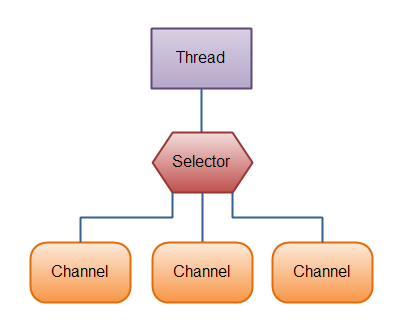非阻塞I/O–Java NIO教程
来源:互联网 发布:淘宝销量少的可以买吗 编辑:程序博客网 时间:2024/05/22 16:59
转载请标明:http://blog.geekcome.com/archives/261
Java NIO核心组件:
- channels
- Buffers
- Selectors
虽然NIO还有其他的组件,上面的三个是核心。
Channel
基本上,所以的IO在NIO中都是从一个Channel开始。Channel有点像流(Stream),数据可以从Channel读取到Buufer,也可以从Buffer写到Channel。Channel有下面的几种类型:
- FileChannel(文件IO)
- DatagramChannel(UDP数据报IO)
- SocketChannel(TCP数据报IO)
- ServerSocketChannel(监听新进来的TCP链接)
Channel和流的区别:
- Channel可以是双向的,流一般是单向的
- Channel可以异步的读写
- Channel总是需要Buffuer来读写数据
ServerSocketChannel:
1ServerSocketChannel serverSocketChannel = ServerSocketChannel.open();2serverSocketChannel.socket().bind(new InetSocketAddress(9999));3while(true){4 SocketChannel socketChannel =5 serverSocketChannel.accept();6 //do something with socketChannel...7}ServerSocketChannel:
1socketChannel.configureBlocking(false);2socketChannel.connect(new InetSocketAddress("http://jenkov.com", 80));3 4while(! socketChannel.finishConnect() ){5 //wait, or do something else...6}Buffer
NIO中Buffer的类型:
- ByteBuffer
- CharBuffer
- DoubleBuffer
- FloatBuffer
- IntBuffer
- LongBuffer
- ShortBuffer
- Mappeddyteuffer
这些Buffer覆盖了你能通过IO发送的数据基本类型,顾名思义。
使用Buffer的四个步骤:
- 写入数据到Buffer
- 调用flip()函数
- 从Buffer中读取数据
- 调用clear()函数
01RandomAccessFile aFile = new RandomAccessFile("/home/yan/pci1","rw");02 FileChannel channel = aFile.getChannel();03 04 ByteBuffer buf = ByteBuffer.allocate(20);05 06 int res = channel.read(buf);07 while(res != -1){08 buf.flip();09 while(buf.hasRemaining()){10 System.out.println((char)buf.getChar());11 }12 buf.clear();13 14 res = channel.read(buf);15 }Buffer还支持多个Buffer组成缓冲数组,对其进程读写操作。
Selector

Selector允许单线程处理多个Channel(一个Channel就是一个连接),如果每个连接的流量都很小,使用Selector就会很方便,如上图所示。而不用每个Channel来新建一个线程处理。
要使用Selector,首先要进程注册,想selector注册Channel,然后调用selector的select方法。这个方法会阻塞到某个注册的事件就绪,一旦这个方法返回,线程就可以处理这些事件。
创建Selector
调用Selector.open()方法来创建一个Selector:
1Selector selector = Selector.open()像Selector注册通道:
1channel.configureBloacking(false);2SelectionKey key = channel.register(selector,SeletionKey.OP_READ);SelectionKey
SelectionKey对象中含有如下属性:
- interest集合(使用&操作SelectionKey.OP_ACCEPT和key.interestOps())
- ready集合(key.readyOps(),可以使用&操作检测该集合,也可以使用is方法)
- Channel(key.channel())
- Selector(key.selector())
- 附加对象(key.attach(obj) Object obj = key.attachment())
selector通道选择
- int select()//阻塞
- int select(long timeout)//超时之前阻塞
- int selectNow()//不阻塞
selectedKeys()
一单调用select方法并且返回了,说明有一个或多个通道就绪了,然后通过该方法选择已经就绪的集合,然后遍历这些集合对每个通道进行处理。
01Set selectedKeys = selector.selectedKeys();02Iterator keyIterator = selectedKeys.iterator();03while(keyIterator.hasNext()) {04 SelectionKey key = keyIterator.next();05 if(key.isAcceptable()) {06 // a connection was accepted by a ServerSocketChannel.07 } else if (key.isConnectable()) {08 // a connection was established with a remote server.09 } else if (key.isReadable()) {10 // a channel is ready for reading11 } else if (key.isWritable()) {12 // a channel is ready for writing13 }14 keyIterator.remove();15}参考文章:http://tutorials.jenkov.com/java-nio/overview.html
- 非阻塞I/O–Java NIO教程
- java NIO(non-blocking I/O) 非阻塞式io
- Java NIO-I/O模型: 阻塞、非阻塞、I/O复用、同步、异步
- 知识点NIO-非阻塞I/O(转)
- 面试知识点NIO-非阻塞I/O(转)
- 面试知识点NIO-非阻塞I/O(转)
- NIO学习笔记(1)--非阻塞I/O
- NIO非阻塞式I/O通信说明
- 非阻塞I/O
- 非阻塞I/O
- 非阻塞I/O
- java NIO 和阻塞I/O的区别
- java NIO 和阻塞I/O的区别
- java nio 非阻塞
- java非阻塞nio
- 非阻塞文件I/O
- 非阻塞I/O简介
- 非阻塞I/O笔记
- iOS-响应上下左右滑动手势
- 360浏览器 根据网页META 自动切换内核
- 关于IOS UITableView的动态高度问题
- 排列 STL
- 堆和栈究竟有什么区别?
- 非阻塞I/O–Java NIO教程
- 也谈谈权限管理:理想状态下的权限管理模型
- OCM_session0_手动建库_os5.4
- zoj1041
- 链表(一)链表的新建、反转、释放
- poj1182食物链(种类并查集)
- 搜索已丢失分区(重建分区表)
- 希尔排序——插入排序的升级版
- ExtJs4学习笔记(五) comboBox使用方法及扩展


